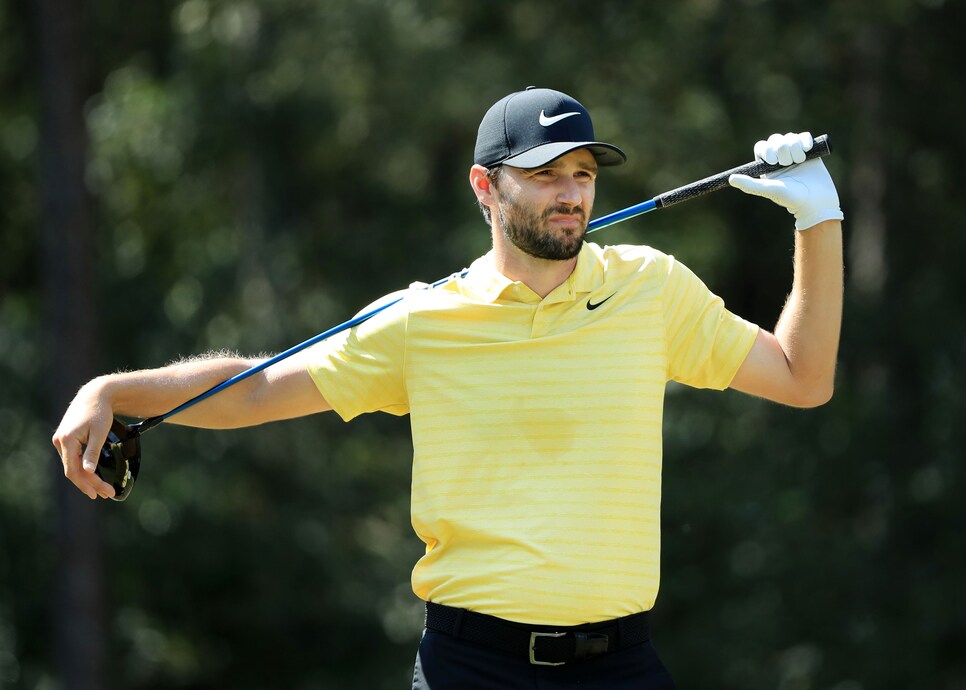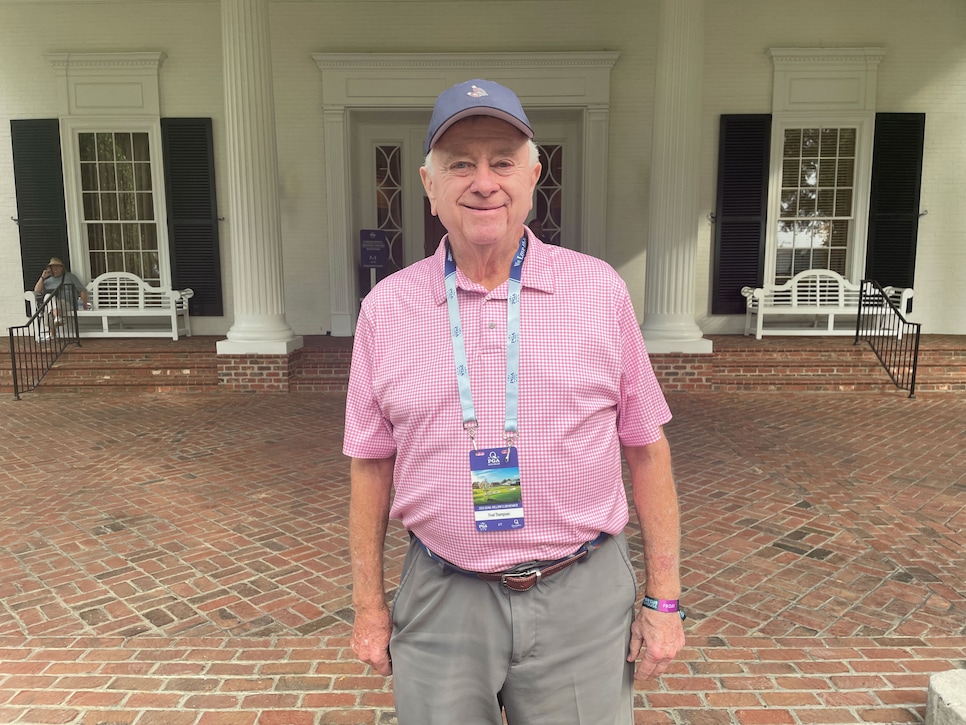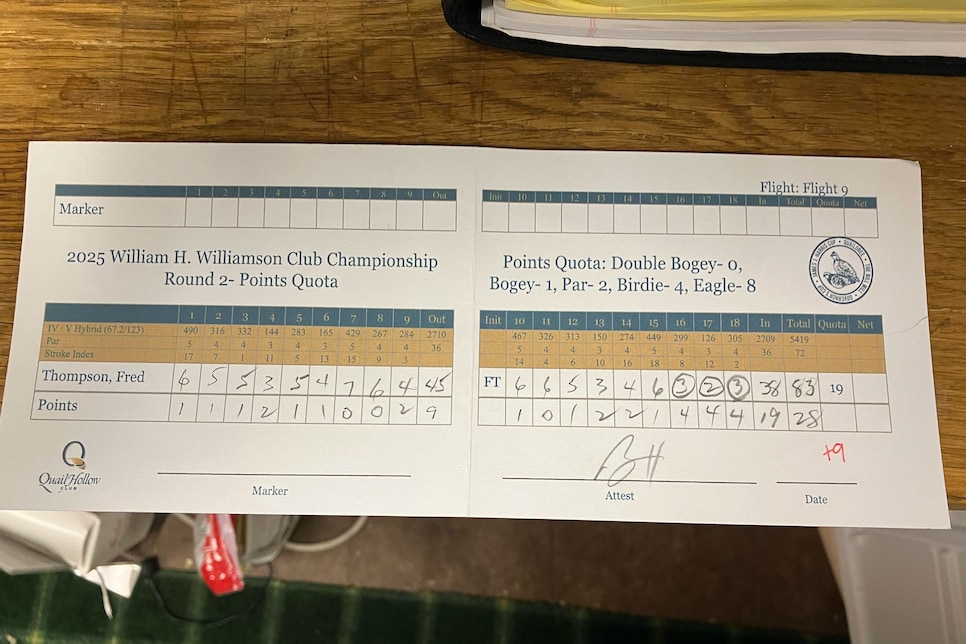CHARLOTTE — By definition, the rarest feat in professional golf—hell, the rarest feat in anything—is something that has been achieved just once.
Enter the Green Mile: Holes 16, 17 and 18 at Quail Hollow. This is the toughest closing three-hole stretch on the PGA Tour over the last 25 years, and with an average of +0.9 over par, it’s, well, “miles” ahead of the nearest competition, Muirfield Village. Phil Mickelson alone has deposited 17 balls into the water here in his career. When the course hosted the 2017 PGA Championship, players shot 488 over par for four rounds on the three holes, setting the standard for the most difficult closing stretch in majors. At this year’s PGA Championship, we’re on track to obliterate that mark—Scottie Scheffler’s performance there on Saturday notwithstanding. It is, bar none, the nastiest troika in professional golf.
Since the PGA Tour first came to Quail Hollow in 2003, more than 14,000 competitive rounds have been played here by the best professional golfers in the world. In an idle moment on Friday, I noticed that nobody had made birdie on all three holes in the same round this year. I checked scoreboards from past years, and though a few players had come close by making birdie on 16 and 17—Abe Ancer, Viktor Hovland, Stewart Cink, Sam Burns, to name a few—none had finished the job with a birdie on 18. I began to wonder if anyone had done it, and when Google searches were inconclusive, I reached out to Morgan Johnson at the PGA Tour. Through all those thousands of rounds in two decades of play, he wrote back, including two PGA Championships, the list of players who had birdied the Green Mile is as short as it gets:
Kyle Stanley, first round, 2019 Wells Fargo Championship
That’s it. One name.
(Stanley finished T-8 that year, and didn’t birdie any of the three holes in his remaining three rounds.)

Kyle Stanley is the only professional to have made three birdies on the Green Mile out of 14,000 rounds played the PGA Tour events at Quail Hollow Club.
Sam Greenwood
Rarity carries with it a certain mystique, and, caught up in the discovery, I called Scott Davenport, the head professional at Quail Hollow, to ask if either he or any of his members had ever managed to birdie their way through the Green Mile. It felt unlikely; if the odds of the best players in the world doing it are 1 in 14,000, even playing on shorter tees and softer conditions didn’t seem sufficient for mere mortals. Davenport has served in his role since 1999, and is one of only two pros in the club’s history. Off the top of his head, he couldn’t remember a single person who had ever done it, but he promised to check.
A few minutes later, he called back with two names. As far as he or anyone at the club knew, these were the only two names. And one of them had been added to the list just three weeks earlier.
Fred Thompson is a longtime member of the “MOs” at Quail Hollow (pronounced “moes”). That’s short for “morons,” and as Thompson says, they’re more than a little notorious around the club.
“We all drive our own cart, we play fast, and I think we sort of terrorize the ladies,” he joked.
Thompson is 82 years old, which is about average for a MO. As another member, Stewart Wallace, explained to me, a lot of the MOs are in their 70s and 80s, and shouldn’t be confused with the slightly younger MITs (“MOs in training”) or the even younger MICE (“Morons in Continuing Education”). Wallace was drafted into the group despite being a relative spring chicken in his early 60s, and he was quick to sing their praises.
“It’s an amazing thing,” he said. “It’s actually one of the better things about Quail. You can’t believe how billionaires will squabble over a $40 bet. It’s literally worth it just for the entertainment.”
Some of the MOs have been playing together for 60 years, although Thompson joined in 1993. He grew up in Lincolnton, N.C., served six years in the Navy, attended law school at UNC Chapel Hill and moved to Charlotte in 1973 to start his career and raise his family. After joining Quail, he served as club treasurer for more than a decade (“an interesting job with Johnny Harris as president,” he said). He’s a 15 handicap now, and a certified junkie who once logged 244 rounds in a single year. The round of his life came at age 70, when for the first and only time he shot under par for 18 holes, carding a 71 at Grandfather Golf and Country Club in Linville, N.C. Today, most of his rounds end in the 90s.
“At 82, my swing speed is lower than my age,” he said.

Fred Thompson joined Quail Hollow in 1993 and plays with a group that affectionately calls themselves the “MOs”—pronounced Moes and short for morons.
One thing he had never done was win a club championship at Quail. There can’t be many players at any level who get the win of their lifetimes after turning 80, but just three weeks ago, that’s exactly what happened to Thompson in the net division. On the last day of the event, he was close to the lead on 16 when he drove the fairway and stuck his 7-iron to 12 feet. The putt would be important, he knew, because the club championship uses Stableford scoring and he needed the birdie points. Using his L.A.B. putter—word around Quail is that it was originally made for Webb Simpson—he buried it.
On the par-3 17th, playing long at 155 yards, he found the green with a 6-iron. The putt was longer this time, 20 feet, but he made that, too. Now he had a real chance to win the tournament, and after another straight drive on 18, he had 145 yards uphill to a back left pin. He pulled the 6-iron one last time and hit a pure approach straight at the flag. He couldn’t tell how close it was from the fairway, but when he drove up, he saw it resting five feet from the pin.
The last time he could remember making three birdies in a row was in the Philippines during his naval service. Still, he didn’t feel nervous as he stood over the last putt—just a sense that he really wanted it to drop.
It dropped.
He finished tied for the lead, and was soon declared the champion because he had the better final round. He shot an 83, and the three birdies he made on the Green Mile were the only three he carded all day. What he didn’t know, until I told him, was that he had joined Kyle Stanley as one of the very few men to birdie out on Quail’s famous closing stretch.
But he and Stanley weren’t alone.

Fred Thompson’s scorecard from the recent club championship, with his 3-2-3 finish attested.
Ben Loudermilk is 25, and he’s trying to live the dream. When we spoke on Saturday morning, he had just shot 69-71 to miss the cut at the Albemarle Championship in North Carolina. It’s the sixth stop on the G Pro Tour, a southeastern minor league where the purses are made up mostly of player entry fees, and usually come in at less than $100,000. This year, he has tried those events, local qualifying for the U.S. Open, and a Korn Ferry Monday qualifier, all without much luck. He grew up in Anderson, S.C., where his grandfather introduced him to golf when he was 5 years old. He got good enough to play in college at Belmont Abbey, a Division II school near Charlotte, where one of his teammates told him that Quail Hollow was looking for caddies. He would help out when he could during the school year, and in the summer of 2022 he stayed in Belmont and helped out with caddies and carts.
On June 18, a hot, sunny day, he was practicing his short game before his shift when Davenport called him up to say a threesome of MOs needed a fourth. This would happen on occasion, and Davenport would typically give the nod to a worker he wanted to reward. Stewart Wallace, a retired banking executive, was one of the members playing with Loudermilk, and he remembers him as exceptionally quiet.
“He didn’t really speak to us the whole round,” he said. “He kind of kept to himself. I think he was a little intimidated.”
Loudermilk, who was 22 then, agreed with that assessment, but if he was feeling nervous, the pressure didn’t show in his game. He played from the members tees with his partners (III Birds on the scorecard), and on the first hole, which plays as a par 5 when the tour’s not in town, he made birdie. He did it again on three, and four, and nine. On the seventh, a 467-yard par 5, he made eagle. When the dust had settled on the front, he carded a 30.
Even after that exhibition, it took Wallace some time to realize what he was witnessing.
“He played the most unremarkable round,” Wallace remembered. “It was remarkably unremarkable, I guess I’d say. Guys like Johnson Wagner or Harold Varner or Mackenzie Hughes play with us a lot, and having them shoot 67 or 68 is not uncommon. We’re used to seeing Harold hit these towering shots 50 yards past us, where you can tell it’s a different level. Ben really didn’t do that. He just hit everything in the middle of the fairway, and it was so nondescript you barely even noticed.”
Loudermilk kept making birdies. First 12, then 13, then 15. After one long putt, Wallace remembers that he finally laughed, aware that something strange was happening; that he could do no wrong. Now they were heading into the Green Mile, and Wallace turned to his playing partner Paul Spengler, a former executive VP of the Pebble Beach Company, and a chairman of the U.S. Opens played at that course in 1992 and 2000.
“I think he might be nine under,” Wallace said.
“He is,” Spengler said. “I’m keeping it.”

Ben Loudermilk was working at Quail Hollow in the summer of 2022 when he got invited to play with a few members and put together the most magical round of his life.
They didn’t dare say anything to Loudermilk. Like a pitcher working on a no-hitter, they left him alone, afraid to disrupt his flow. But what astounded Wallace then, and still does today, is that Loudermilk wasn’t hitting it especially close on any hole, nor was he driving so far that he had flip wedges into the greens. He just kept making long putts, one after another. And if you’re wondering whether any putts were conceded, the answer is an emphatic no: This was a money match, and Loudermilk wasn’t even scooping the tap-ins.
On 16, he carried the bunker with his drive and hit his approach to 10 feet—birdie. His tee shot on 17 almost went in the hole, and he tapped in for his 2. Now he had a chance to card a 60 with a final birdie on 18, but a wayward drive into the pine straw on the right right seemed to end that hope for good, especially with a tough back right pin location. He told himself to get the ball on the green safely, and pray for a good lag to save par and card a 61.
He did the first part—his approach crawled onto the front right portion of the green that juts out by the bunker. He left himself about 60 feet uphill, which is about as hard a two-putt as you can find at Quail. Wallace, now fully invested, gave him a member’s read. When Loudermilk hit the putt, he liked the speed and the line, and started to think it might get close. Then he started to think it might get very close.
And then it went in.
He had shot an unthinkable 60. It was a new course record from the members tees. Wallace and Spengler couldn’t contain themselves, and were literally jumping up and down as Loudermilk’s shyness gave way to delirium.
“I was going bananas, too,” he said.
Spengler, now in his 80s, has had a long and storied career in golf. He’s a three-time Hawaii state amateur champ who finished second in the team NCAA Championship in 1961 when Jack Nicklaus won the title, and he watched Tiger’s blowout victory at the 2000 U.S. Open in person. Before the group even shook hands on the 18th green, he told Loudermilk it was the most incredible round he had ever seen, and he handed him the scorecard. When they got back to the clubhouse, they broke club protocol by inviting Loudermilk up for a beer. Employees rarely got that privilege, but if nothing else, they had to tell the story, to show him off, and to convince everyone (and themselves) that what they had just witnessed was real.
At some point in the celebration, Wallace turned to Loudermilk and rattled off the questions that flooded his mind: Who are you? Where did you come from? What’s your best round at Quail besides this one?
“Mr. Wallace,” he said, “I’ve never broken par here before.”

Quail Hollow’s Green Mile finishing holes from above (clockwise from right, No. 16, No. 17 and No. 18).
If you need proof that Loudermilk is a real golfer, consider what he said about the moment when the miracle putt dropped on 18.
“I was happy, and I was upset.”
How could you be upset?
“Because I’ll bring this back to No. 10, the par 5. I got on the green in two, the pin was front left, and I ended up three-putting for par.”
And that’s what cost you the 59.
“Yeah. No. 10 cost me the 59.”
But he doesn’t sweat it too much. He knows it was the round of his life—his second best was a 64—and now he knows that along with the course record, he’s part of a small, elite group that went birdie-birdie-birdie on the Green Mile.
Bragging was never Loudermilk’s style, and he’s too humble to tell anyone about that day if they don’t ask. Even when someone does ask, you get the sense that the magic lives in a place just beyond words. He can tell you the clubs and distances and results, but the mystery is harder to crack.
“I don’t know,” he’ll say. “It’s just special.”
But the scorecard Spengler gave him stays in his room, and tells a story that never gets old. Every so often he’ll take a moment to look at it, and to remember.
MORE GOLF DIGEST PGA CHAMPIONSHIP COVERAGE
PGA Championship 101: Answering all your frequently asked questions
How to watch the 2025 PGA Championship
Power Rankings: Every player in the PGA field, ranked
The 13 best bets to win at Quail Hollow
Tee times for the second round
Crunching the numbers: Why Rory McIlroy is so good at Quail Hollow
Quail Hollow’s three-hole stretch that could decide the PGA Championship
PGA Championship: Better in May or August?
Where have all the Cinderella major champions gone?
The things that still shock us from Scottie Scheffler’s bizarre arrest at the 2024 PGA
The most ‘PGA’ moments in PGA Championship history
This article was originally published on golfdigest.com

